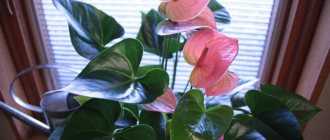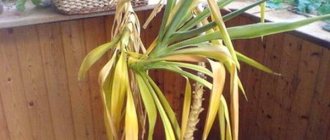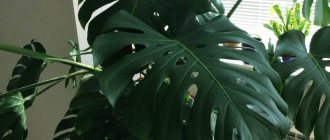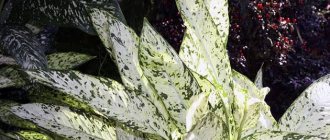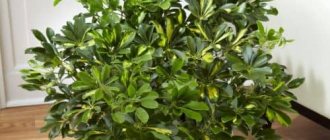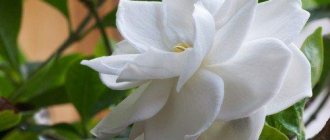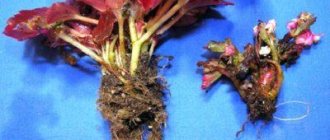Watering with cold or hard water is also detrimental to the bush. And in order not to look for how to urgently revive anthurium at home, water for irrigation should not only be left standing for several days, but also frozen. The use of hard water is manifested by the formation of black tips of the leaves.
Important! Deformed and yellow parts of the plant are cut off with a sharp knife, after wiping it with alcohol. For large cuts, the surgical sites are sprinkled with charcoal.
What to do in hopeless situations
How to revive anthurium without leaves at home? It is worth remembering that the plant is an epiphyte and also reproduces by aerial roots. If the plant has dropped its leaves, it should be removed from the pot and carefully examined for infections and pests. After treatment with special chemicals (fungicides or insecticides), if there is at least one living “bump” - an aerial root - you can hope for salvation.
Resuscitation measures include inspection of the root system. The gardener should remember that the root system of anthurium is very fragile and therefore requires careful behavior. Only the white, fleshy roots are alive. Black and yellow elements are no longer able to provide the above-ground part of the plant with nutrition. If there are living roots, it is worth trying to revive the bush by replanting it in fresh soil and creating the right conditions.
Resuscitation or rejuvenation is carried out in 2 ways:
- The actions are aimed at activating aerial roots, which actively develop in a warm and humid environment. Anthurium has no roots, what to do is to wrap the sprout with damp sphagnum moss in the place where the tubercles of undeveloped aerial roots are visible and place it in a humid environment. Full roots grow within 2-3 weeks. Cut off a strong sprout from the mother plant and plant it in a separate pot.
Root the sprout directly in the pot. The above-ground part is cut off and placed in a humid environment. To create it, drainage and nutrient soil are poured into the pot, and a ball of sphagnum moss is placed. As the roots develop, they reach nutritious soil and the plant gains strength and endurance. If the sprout is elongated, it can be divided into segments. The appearance of young leaves indicates that the plant has taken root.
In order to see the condition of the roots, they should be soaked in warm water and washed carefully. All damaged roots and rotten specimens are cut off, and the cut areas are sprinkled with activated carbon. Living growth points are visible to the naked eye. After pruning, the roots are transplanted into fresh soil.
Important! Rooting anthurium with sphagnum moss gives high positive results, since this natural material not only perfectly retains moisture, but also provides a bactericidal effect.
Draft and cold
If the leaves of an anthurium dry out, what should you do (the photo shows a clear example of this problem) to save the plant? Flower growers answer: you cannot place a flower pot near the balcony door, which residents often open in winter. If you ignore this advice, there is a high probability that the anthurium leaves will dry out. To protect the plant from drafts and cold air, it must be taken out of the room for ventilation.
You may be interested in: Violet Sagittarius Elite: description, content
If the leaves of the anthurium are slightly frozen, the plant can be restored. All damaged organs of the flower must be carefully cut off and placed in a warm room. The next step is to treat the plant with a biogrowth stimulator. However, the root may be damaged, so in this case you will have to replant the anthurium after cutting off the rotten areas. It is advisable to treat the cut areas with cinnamon.
How to revive a dying anthurium?
If the plant comes to you in very poor condition, do not rush to get rid of it. Perhaps the anthurium can still be saved.
A small stunted anthurium came to me in an excessively large pot and with a lump of earth, which had long ago turned into a hard stone. I soaked the dried earthen lump in water for a long time. When I finally managed to do this, I was horrified to discover that there were no roots there at all: they were dry and fell off when touched. Having torn off all the dried leaves and cleared the plant of dead “crusts”, I discovered a living core. I decided not to root it in water.
I mixed the soil for seedlings with washed sand, added wood ash and deepened the plant into the resulting soil mixture, without covering it with a jar on top, for fear of causing rot. I just put it in partial shade. Regularly sprayed with Kendal solution (biostimulator).
For almost six months the plant showed no signs of life, but it did not die either. And I decided to take it out of the ground. I pulled and it didn’t budge. As a result, I found three thick white roots, one of which broke off when I pulled it out of the ground. Since then, I have tried to be very careful when transplanting. Having carefully cut off the broken root, sprinkled it with ash and transplanted the plant into fresh soil. I took a ready-made substrate for ornamental flowering plants, added a little coniferous peat - the result was a light, fertile mixture. A layer of expanded clay was placed on the bottom of the pot.
Watering and replanting
Anthurium began to grow with incredible speed. Three shoots appeared at once from above, releasing new roots from the side, six dark green glossy leaves opened in all their splendor. warm showers weekly while he was without flowers. But when flowers appear, I do it carefully. Before starting water procedures, be sure to put a plastic bag on the inflorescence, since when water gets on the flower, unsightly black marks remain and it quickly fades. You can not spray the anthurium, but wipe the leaves with a damp sponge on both sides.
A year later, my ward turned into an excellent specimen of Scherzer's anthurium (A. scherzerianum), which produced 2 scarlet flowers with charming curled pink tails. I replant the anthurium every 2 years in the spring into the soil mixture that I wrote about above. During transplantation, strongly overgrown specimens can be divided or the lateral processes can be separated.
Pests
Unfortunately, mealybugs and scale insects . It is very convenient to remove pests with an old toothbrush, and then wash the plant with calendula infusion: pour half a glass of dry calendula with a glass of boiling water, leave overnight. Then I wet the cotton swab well and wipe all the affected areas. I continue this treatment until the pests disappear. Using an alcohol solution to remove insects will also be effective. However, this method helps as long as the number of parasites is small. If there are a lot of pests, before treating with calendula I use a solution of liquid soap (for washing dishes). I try not to use chemicals.
Irrigation violation
Anthurium does not tolerate both waterlogging and lack of moisture. The roots of the plant are sensitive to excess water. Moist soil is an ideal environment for bacteria and fungi. In addition, anthurium can only be watered with melted or settled water (settling time is at least two days)
If the plant stays in waterlogged soil for a long time, the tips of the anthurium leaves will begin to dry out. What to do in this unpleasant situation, when tissue necrosis begins to develop from the edges and gradually spreads to the entire leaf? To solve this problem, you need to dry the soil in the pot. If this does not help, it means that the root system of the plant has rotted, so the leaves lack nutrients. There is only one solution - remove the damaged parts and replant the anthurium in fresh soil.
However, the leaves may begin to dry out in the middle. The reason for this may be accidental ingress of water onto the leaf plates. For sunlight, such drops are a kind of lens, so they will simply burn through the living tissue of the plant. In addition, in anthurium that is in a cool room, improper watering can cause fungal disease.
Signs of the need for flower rejuvenation
If an anthurium disappears, most likely it’s time to rejuvenate it.
The following signs indicate this:
- an elongated stump with leaves remained from the plant;
- there are fewer leaves and more side stems;
- the flowers stopped blooming;
- the buds became smaller in size.
the trunk was exposed at the bottom;
Depending on the conditions, the need for rejuvenation occurs 5–10 years after purchase.
The condition of the plant is adversely affected by the owner’s mistakes:
- frequent drafts;
- daylight hours are shorter than 12 hours;
- exposure to direct sunlight;
- air temperature below +17°C and above +25°C;
- humidity below 80%;
- waterlogging of the soil and stagnation of water;
- complete drying of the substrate;
- lack of fertilizing;
- watering with hard water;
- neglect of transplants;
- untimely treatment of diseases.
The leaves are turning yellow
There may be several reasons for the yellowing of the leaf blade of anthurium. But all of them are associated with a violation of the technique of growing a flower. Let's look at the causes of yellowing leaves and methods of treating the disease:
- If you find yellow leaves on a young bush, this indicates an excess of sun. Young plants are very sensitive and need diffused light. Shade the window and be sure to observe the behavior of the anthurium.
- Young anthuriums lack the rich color of the leaf blades - they are faded and unusually large. These signs mean that the owner has added too much fertilizer to the soil and the flower does not have time to absorb it. In this situation, you need to temporarily abandon fertilizers and increase watering. If fertilizers have not been applied to the soil and the plant exhibits the same signs, then, on the contrary, it needs to be “fed.”
- The lower leaves of the plant turn yellow - a direct sign of aging anthurium. The solution to the problem in this situation will be to rejuvenate the bush, as well as remove yellowed leaves using a sharp knife.
It also happens that yellowness is not observed in the leaves, but they are pale and do not have a rich green color. The reason for this is the lack of lighting. Move the pot closer to the light or provide additional lighting sources. You can purchase special phytolamps if this situation occurs in winter.
Signs of improper flower maintenance
Anthurium suffers from improper care and immediately signals this to the owner. By external changes you can determine what mistake was made.
| Sign | Error in care |
| The leaves are curling | Little light, dry air |
| Black spots on leaves | Stagnation of water in the substrate |
| Yellow leaf tips | Drafts, low temperature |
| Black tips of leaves | Watering with hard and cold water |
Errors in care
Anthurium is a capricious plant and improper maintenance conditions, as well as errors in care, immediately affect the beauty of its leaves.
Features of watering
The most common reason why anthurium leaves turn yellow. Moreover, it is associated with both excessive and insufficient irrigation. Watering with hard and cold water also causes yellowing.
To avoid this, you need to adhere to the following rules:
- For irrigation it is better to use melt or rain water.
- Tap water will need to be filtered and softened with a small amount of citric or acetic acid. But the acid should not be tasted. Also, the liquid must be left to stand for at least 1 day.
- Immediately before watering, the water must be heated to a temperature of +18…+24 °C.
- The plant should be watered only after the top layer of soil has dried.
- After 30 min. After the event, it is necessary to drain excess moisture from the pallet.
Excess fertilizer
Anthurium needs regular feeding, but an excess of fertilizers is harmful for it. So you need to apply medications from spring to autumn no more than once every 14 days. In winter, it is enough to feed the flower once a month. You should also use only half the dose specified by the manufacturer.
If the leaves of the plant begin to turn yellow for this reason, then first you should stop feeding for 1 month. If the measure does not help, then you need to transplant the plant into a new substrate.
Unbalanced fertilizer
Macronutrient imbalances can cause leaves to turn yellow.
Excess or deficiency of substances manifests itself in different ways:
- The lower leaves turn yellow, and the upper ones develop poorly. This is how the plant reacts to a lack of nitrogen. You need to feed the flower with ammonium sulfate, ammonium nitrate, mullein solution or bird droppings.
- Young leaves turn yellow. This indicates a lack of sulfur. The element can be replenished with magnesium, potassium or ammonium sulfate.
- The leaves turn yellow over the entire surface, but the veins remain bright green. This is how iron deficiency manifests itself. For fertilizing it is worth using iron sulfate. But the dose of fertilizer should be minimal, otherwise its excess will destroy the plant.
- Yellow spots form on the leaves, and over time they wrinkle and fall off. This behavior indicates a lack of manganese. To correct the situation, you need to water the plant with a weak solution of potassium permanganate once a month.
Lighting
When exposed to direct sunlight, burns form on anthurium leaves - large yellow spots. Over time, they dry out and become dark brown or black. If this happens, you will need to remove all damaged leaves.
And to avoid a repetition of the situation, you should move the plant with diffused lighting, for example, to a western or eastern window sill.
An example of yellowing of anthurium leaves.
If the leaves turn yellow, turn pale and stretch out, this indicates a lack of lighting. This phenomenon often occurs in autumn and winter, when solar activity is low. To correct the situation, you need to move the plant closer to the window or provide it with additional lighting with a phytolamp.
Draft
Anthurium does not tolerate drafts and sudden temperature changes. When the temperature drops to +10…+15 °C, the lower leaves turn yellow en masse. To prevent this situation, you need to keep the plant in a protected, warm place. During ventilation, it is worth taking it to another room.
Choosing a pot
Anthurium does not develop well in either too small or too spacious a pot. It often reacts to planting in an unsuitable container by yellowing the leaves.
So you need to choose flowerpots that are 1-2 cm larger than the root system of the plant. If the pot is too deep, then it should be filled 1/3 of the volume with drainage.
Soil selection
It is difficult to extract water and nutrients from dense and heavy soil, which immediately affects its decorative properties and leads to yellowing of the leaves. The flower must be planted in a light, loose substrate intended for these plants. It is better to add perlite, sand or other leavening agents to the mixture.
Anthurium cannot be called an unpretentious plant, because improper care has a negative impact on the decorativeness of the plant. Under unfavorable conditions, its leaves turn yellow and wither, and this can be caused by various reasons: from irregular watering and fertilizing to planting in the wrong pot.
How to save anthurium from death at home
To save the anthurium, it needs to be rejuvenated.
Rejuvenation is carried out in two ways:
- Activation of aerial roots . This plant is epiphytic and has aerial roots. Wrap them in damp sphagnum moss and leave them in a warm place. Soon the roots will sprout, and then they can be cut from the stem. There is no need to remove the moss. Aerial roots now perform the functions of a seedling. They can be planted in a pot and wait for further growth.
- Rooting the top . Cut off the top of the plant along with a few growing points. Place it in warm water and keep it in a room with a temperature of at least +21°C. Soon the plant will take root, after which it can be planted in a pot.
Transfer to another container
Transplantation can also help the plant.
Do it this way:
- Place drainage mixture at the bottom of the new container.
- Fill the container one third with pre-prepared substrate.
- Carefully remove the plant from the old pot.
- Inspect the roots for rot. Cut off the rotting part, treat the cut with crushed activated carbon.
- Place the flower in a new container and straighten the roots.
- Pour the rest of the substrate into the pot.
The type of pot is important for replanting. It is better to choose a transparent plastic container - this way the grower will be able to monitor the condition of the root system. The size should be comparable to the size of the roots. The root system should fit completely into the container, but still have room for the substrate.
Video: Anthurim rejuvenation
Choosing soil for plant rooting
Soil plays an important role for a flower. In the right substrate, the plant will quickly take root and grow.
- loose;
- slightly acidic;
- ventilated;
- coarse fiber.
The substrate can be prepared according to several recipes.
For the first recipe you need to mix:
- 2 parts of turf;
- 2 parts peat crumbs;
- 1 part crushed moss.
The second way to prepare the substrate is to combine in equal parts:
- leaf soil;
- sand;
- coal;
- pine bark;
- peat crumbs.
To save time, many gardeners buy ready-made soil mixtures. Manufacturers offer a large selection of substrates that are ideal for demanding flowers.
Features of care
Anthurium is a demanding plant.
All care procedures are important for him, including watering, fertilizing, pruning and replanting:
- Watering . Moisten the soil when the top layer of the substrate dries out. Do not let the soil mixture dry out, but do not flood the roots. Pay attention to the air temperature: the colder the room, the less often you need to water the flower.
- Fertilizer . Apply liquid fertilizer every 2-3 weeks from March to August. The best choice is complex mineral fertilizers. The flower tolerates organic matter well, but flower growers advise using preparations based on nutrient salts.
- Trimming . After flowering ends, it is better to trim the buds. Pruning is carried out only with a sharp knife, cutting off the flower at the very base. It is advisable to disinfect the cut by rubbing it with ash.
- Transplant . The roots of the flower grow larger with age. They become cramped in an old pot, so the plant needs to be replanted regularly. Young anthuriums grow faster, so they should be replanted annually. Older plants do not develop as intensively - they are replanted every 2-3 years. The procedure is best carried out in the spring.
Useful tips for caring for anthurium
Anthurium is a very demanding plant. When growing it, it is not enough to follow basic agricultural techniques. It is also important to take into account the nuances of the flower.
When caring, pay attention to the recommendations of experienced flower growers:
- add bone meal to any type of substrate for better ventilation;
- use expanded clay, sand or dried cuttings as drainage;
- after purchasing a flower, be sure to replant it in a suitable pot and soil - store-bought substrate is usually not suitable for it;
- When replanting, it is good to plant children that grow on the trunk as it develops.
Anthurium is a fastidious plant that requires proper care. If you do not monitor the growing conditions, the flower may die. However, with timely rejuvenation, it will be saved and in the future will continue to delight the owner with bright flowering.
LiveInternetLiveInternet
–Categories
- ORTHODOXY (14)
- HANDMADE (14)
- beads (1)
- BUSINESS, FINANCE (0)
- IN THE WORLD OF ANIMALS (0)
- EVERYTHING FOR CHILDREN (2)
- EMBROIDERY (1)
- KNITTING (359)
- compilations (333)
- crochet (8)
- for women (4)
- for men (2)
- master classes (2)
- patterns (2)
- children (1)
- FOR THE COTTAGE AND GARDEN (206)
- BEAUTY and HEALTH (90)
- diets, weight loss (27)
- good for health (23)
- face masks (1)
- traditional medicine (35)
- hair care (5)
- foot care (1)
- COOKING (4030)
- collections of recipes (499)
- pies, pies (255)
- poultry dishes (232)
- for dessert (221)
- baked goods (130)
- pancakes, pancakes (115)
- main courses (113)
- minced meat (107)
- jam (97)
- sauces, dressings, marinades (78)
- vegetable dishes (73)
- cottage cheese dishes (59)
- for breakfast (58)
- from offal (57)
- for Easter (55)
- Lenten dishes (47)
- dough (45)
- side dish (42)
- pasta and cereals (31)
- pizza (29)
- culinary tricks (25)
- recipes with lavash (24)
- egg dishes (19)
- sausages, dishes with sausages (14)
- fast food (10)
- for multicooker (8)
- cheeses (2)
- fish dishes (155)
- dishes with mushrooms (44)
- winter preparations (222)
- snacks (235)
- casseroles (74)
- potato dishes (125)
- porridge (28)
- shrimp, squid, seafood (23)
- meat dishes (156)
- drinks (100)
- food decoration (1)
- salads (231)
- sweet pastries (38)
- soups (196)
- cakes (107)
- HOLIDAYS (34)
- New Year (12)
- Christmas (9)
- Easter (7)
- Valentine's Day (2)
- February 23 (1)
- March 8 (1)
- MISCELLANEOUS UTILITIES (18)
- SPORTS (2)
- COMFORT IN THE HOUSE (180)
- indoor plants (176)
- SEWING (1)
- ESOTERICA, MAGIC, ASTROLOGY (12)
- THIS IS INTERESTING (6)
–Tags
-Statistics
Reanimating a dying anthurium plant
Monday, July 23, 2022 15:53 + to quote book
A beautiful, long-blooming anthurium takes pride of place in the apartment. Bright flowers and beautiful arrow-shaped leaves of the anthurium plant are the hallmark of a home where there is enough love and care for all its inhabitants. A demanding flower loses its decorative effect at the slightest deviation from the maintenance norm. Flowers become especially capricious over the years, losing foliage.
Signs of the need for flower rejuvenation
- the high anthurium stem was exposed from below;
- the flowers are crushed or the plant does not bloom;
- the leaves become smaller, many side shoots appear;
- The trunk stretches and the leaves fall off.
In any case, if a flower has lost its decorative value, and it is a pity to part with it, it should be revived. But first, carry out an analysis and determine what is missing in agricultural technology, so that in the future the plant will delight you with its appearance for a long time.
Basic care requirements:
- year-round exposure to light without direct sunlight, providing at least 12 hours of daylight;
- exclusion of any kind of drafts;
- creating a comfortable temperature of the surrounding air and ground;
- creating a zone of high humidity around the flower by any kind of evaporation and spraying;
- soil that meets the requirements and watering without stagnation of water in the pot;
- regular watering with settled soft water and fertilizing the plant;
- timely transplantation and propagation;
- control of diseases and pests.
If a set of measures is completed, then the anthurium will not need rejuvenation for a long time.
Brown dry spots on anthurium
If the anthurium is sick. Brown spots on leaves
Many fans of indoor plants have anthurium in their home collection. It is valued for its unusually beautiful flowers and wide shiny leaves. The difficulty in caring for anthurium lies in the need to create and maintain optimal conditions under which the plant will develop well and will not be affected by pests and diseases.
Sometimes gardeners begin to notice how brown dry spots appear on the anthurium, which spoils the appearance of the flower. It should be noted that most diseases are associated with non-compliance with plant care rules.
Features of caring for anthurium
Anthurium is a tropical plant, and therefore requires special conditions for cultivation and care. An important point is to choose the right place where the flower will stand, since it loves light, but direct sunlight is harmful to it. When constantly exposed to such lighting, the leaves begin to curl into a tube.
Drafts are also harmful to the flower. The optimal temperature, which is considered comfortable for the plant, is the range between 20 and 25 degrees Celsius. In addition, the soil must be at the same temperature as the air in the room.
Daily spraying of anthurium is recommended, as it prefers high air humidity. At the same time, you need to try to prevent water from getting on the flowers themselves, otherwise stains may appear on them, which will affect their decorative effect.
Water the plant moderately, making sure that the earthen ball does not dry out, but remains slightly moist. Water for irrigation is used warm and well-settled; stagnation is not allowed.
Causes of spots on plant leaves
Since the plant is afraid of drafts, the result of staying in such conditions will be the appearance of large brown spots. You need to move the flower to a warm place and reduce watering to stop their development.
If the diameter of the spots is not large, then most likely this is a consequence of sunburn. Anthurium should be moved to partial shade, where it will be much more comfortable.
If the leaf blades of the anthurium are completely covered with brown dry spots, and the size of the new growing leaves is much larger than the previous ones, then the reason lies in the excessive amount of fertilizer used to feed the plant.
Sometimes the plant is affected by mealybugs. The above-ground parts of the flower provide an excellent environment for their life. This also leads to brown dry spots appearing on the anthurium. If no pest control measures are taken for a long time, the leaves may fall off. A good remedy for mealybugs is treatment with karbofos.
Yellowing and dying of old anthurium leaves located at the bottom of the plant is a natural process. Sometimes adult plants can lose their attractiveness because of this, so flower growers practice flower rejuvenation.
Fungal diseases of anthurium
The most common fungal disease of anthurium is septoria. With it, the leaf plate is covered with brown spots, along the edges of which there is a noticeable border of a light color, and inside there are dark dots.
In this case, the concentration of substances should be weak.
To ensure that the anthurium blooms abundantly and the leaves are shiny and clean without any stains, you need to be careful when feeding the plant. Fertilizers are applied no more than once every fourteen days
Any universal fertilizer is suitable for fertilizing.
Any universal fertilizer is suitable for fertilizing.
The only thing you should pay attention to is during the flowering period of anthurium; here the priority should be special mixtures for decorative flowering plants, such as “Agricola”, “Fertika-lux”, “Pokon” and others. Particular attention must be paid to the dosage of fertilizers; their concentration should be halved from that recommended on the packaging with the drug
Particular attention must be paid to the dosage of fertilizers; their concentration should be halved from that recommended on the packaging with the drug
Please rate the material you read :)
Particular attention must be paid to the dosage of fertilizers; their concentration should be halved from that recommended on the packaging with the drug. Please rate the material you read :)
Please rate the material you read :)
Please rate the material you read :)
(7 rated, score: 5.86 out of 10) Loading...
Signs of improper flower maintenance
If the leaves begin to curl into a tube, reducing the surface area, this is already a signal of a lack or excess of light and dry air. If black spots appear on the leaves, the plant is watered abundantly and stagnant zones appear in the substrate. The tips of the leaves begin to turn yellow, you need to increase the air temperature and eliminate the draft.
Yellow leaves and stems of dried flowers should be cut off with scissors, after disinfecting them in order to stop damage to the plant.
Causes of drying out
Making a diagnosis and starting treatment for a plant is a difficult task, since most often the disease occurs due to improper care. If anthurium leaves dry out, what should you do to fix it? Few gardeners know the answer to this question. As a rule, such a nuisance occurs when the flower is in a room whose humidity does not correspond to the required level for proper plant growth, equal to 65–80%.
In this case, the anthurium will be attacked by spider mites, which will cause the leaves to lose their fresh appearance, turn yellow and curl. In turn, in rooms without normal ventilation, there is a high probability that the plant will be exposed to an infectious disease.
But there are many other reasons why leaves begin to dry:
The result of a long violation of the maintenance rules is a dead plant. Experienced flower growers should definitely know why anthurium leaves dry out. According to them, this can also happen due to an attack by insects, the result of whose harmful activity is a damaged root system of the plant, and consequently, the destruction of the above-ground part. However, it is necessary to take a closer look at the main reasons so that beginners growing anthurium can cure it in a timely manner.
The flower is dying, how to save anthurium
How to rejuvenate anthurium
- activating aerial roots;
- restoring the functionality of the root system.
Aerial roots will begin to develop in a warm and humid environment. Therefore, the best way is to place the plant in a warm place and create a belt of sphagnum moss around the growth points of future roots. In a constantly moist substrate, the plant will take root within a week or two. Then this part can be cut off with a sharp, disinfected knife, sprinkled with crushed charcoal or ground cinnamon.
Such a seedling can be immediately rooted in a pot by preparing the necessary composition of tropical soil. Sphagnum will not interfere with this; the roots will break through the pores of the moss and reach the nutrient mixture.
But if the plant is very elongated, then in this way you can root another piece of the plant stem. During root growth, the plant is not watered so as not to spoil the idle soil. It is only sprayed from above. As a harbinger of the salvation of the anthurium, a new leaf will soon appear on the seedling. After this, create conditions for the anthurium to develop as quickly as possible. The plant will not need feeding for the first 2-3 months, the soil is full, but there are still few roots.
Plant the plant according to all the rules and wait for the result. Such work may not be necessary if only the above-ground part of the anthurium dies, the roots remain viable. Then, after cutting off the top for separate rooting, the entire pot is left at rest in a warm and bright place. After some time, young shoots should appear, which can later be planted. This is also one of the ways to rejuvenate anthurium.
A significant role in the revival of plants is played by subsequent care for them, as for a loved one who is recovering from a serious illness.
Dry air
This is a fairly common problem in homes with central heating. If the tips of the leaves of an anthurium dry out, the plant may lack moisture, because it evaporates too quickly in a heated room. More often this happens when the flower stands on a wide windowsill, under which a heating radiator is installed. There are several ways to increase humidity and improve the microclimate of the room for better growth of anthurium:
- Place the pot with the plant on a tray with damp expanded clay or sphangum (another name is peat moss).
- Constantly spray the leaves with warm water so that the drops do not fall on the inflorescences.
- Place a special humidifier next to the anthurium.
- Place a container of water near the battery or place a wet towel over it.
In any case, placing an anthurium near a heating device is a bad idea. In addition, you should not water the plant frequently to increase the humidity in the room.
Composition of soil for rooting anthurium
The recommendations for adding a large amount of sphagnum moss are correct; in addition to its moisture-retaining properties, it is also bactericidal. The danger is that if the soil has dried out on top, the moss near the root retains moisture, so there is a danger of overwatering the plant. Perlite and vermiculite hold moisture in the soil well, releasing it when necessary. Ground charcoal makes the substrate porous and creates centers for the formation of nutrition for the plant. Bark, necessarily, high peat, leaf substrate provide the necessary acidity. Sand is a source of silicic acid. A small amount of vermicompost fills the composition with beneficial microflora. All these substances are vital in the soil. It is good to use vermiculite as a top fill so that the moisture from the pot evaporates less.
Anthurium transplantation - video
Signs of the need for flower rejuvenation
- the anthurium stem was exposed high up from below,
- the flowers are crushed or the plant does not bloom,
- leaves become smaller, many side shoots appear,
- The trunk stretches and the leaves fall off.
In any case, if a flower has lost its decorative value, and it is a pity to part with it, it should be revived. But first, carry out an analysis and determine what is missing in agricultural technology, so that in the future the plant will delight you with its appearance for a long time.
Basic care requirements:
- year-round exposure to light without direct sunlight, providing at least 12 hours of daylight,
- exclusion of any kind of drafts,
- creating a comfortable temperature of the surrounding air and ground,
- creating a zone of high humidity around the flower by any kind of evaporation and spraying,
- soil that meets the requirements and watering without stagnation of water in the pot,
- regular watering with settled soft water and fertilizing the plant,
- timely transplantation and reproduction,
- control of diseases and pests.
If a set of measures is completed, then the anthurium will not need rejuvenation for a long time.
Signs of improper flower maintenance
If the leaves begin to curl into a tube, reducing the surface area, this is already a signal of a lack or excess of light and dry air. If black spots appear on the leaves, the plant is watered abundantly and stagnant zones appear in the substrate. The tips of the leaves begin to turn yellow, you need to increase the air temperature and eliminate the draft.
Yellow leaves and stems of dried flowers should be cut off with scissors, after disinfecting them in order to stop damage to the plant.
Anthurium leaves dry out in patches due to pests: what to do
The plant may turn yellow not only due to improper maintenance conditions. An equally common cause is leaf damage by various pests:
The main thing is to clean the anthurium with water a day after the chemical treatment to protect the plant from toxic substances. But first you need to protect the soil from excess moisture with plastic film.
How to rejuvenate anthurium
- activating aerial roots,
- restoring the functionality of the root system.
Aerial roots will begin to develop in a warm and humid environment. Therefore, the best way is to place the plant in a warm place and create a belt of sphagnum moss around the growth points of future roots. In a constantly moist substrate, the plant will take root within a week or two. Then this part can be cut off with a sharp, disinfected knife, sprinkled with crushed charcoal or ground cinnamon.
Such a seedling can be immediately rooted in a pot by preparing the necessary composition of tropical soil. Sphagnum will not interfere with this; the roots will break through the pores of the moss and reach the nutrient mixture.
But if the plant is very elongated, then in this way you can root another piece of the plant stem. During root growth, the plant is not watered so as not to spoil the idle soil. It is only sprayed from above. As a harbinger of the salvation of the anthurium, a new leaf will soon appear on the seedling. After this, create conditions for the anthurium to develop as quickly as possible. The plant will not need feeding for the first 2-3 months, the soil is full, but there are still few roots.
Plant the plant according to all the rules and wait for the result. Such work may not be necessary if only the above-ground part of the anthurium dies, the roots remain viable. Then, after cutting off the top for separate rooting, the entire pot is left at rest in a warm and bright place. After some time, young shoots should appear, which can later be planted. This is also one of the ways to rejuvenate anthurium.
A significant role in the revival of plants is played by subsequent care for them, as for a loved one who is recovering from a serious illness.
Infectious diseases
If the leaves of an anthurium dry out, the flower needs to be isolated from healthy plants, examined and a final diagnosis made. The following diseases exist:
Composition of soil for rooting anthurium
The recommendations for adding a large amount of sphagnum moss are correct; in addition to its moisture-retaining properties, it is also bactericidal. The danger is that if the soil has dried out on top, the moss near the root retains moisture, so there is a danger of overwatering the plant. Perlite and vermiculite hold moisture in the soil well, releasing it when necessary. Ground charcoal makes the substrate porous and creates centers for the formation of nutrition for the plant. Bark, necessarily, high peat, leaf substrate provide the necessary acidity. Sand is a source of silicic acid. A small amount of vermicompost fills the composition with beneficial microflora. All these substances are vital in the soil. It is good to use vermiculite as a top fill so that the moisture from the pot evaporates less.

